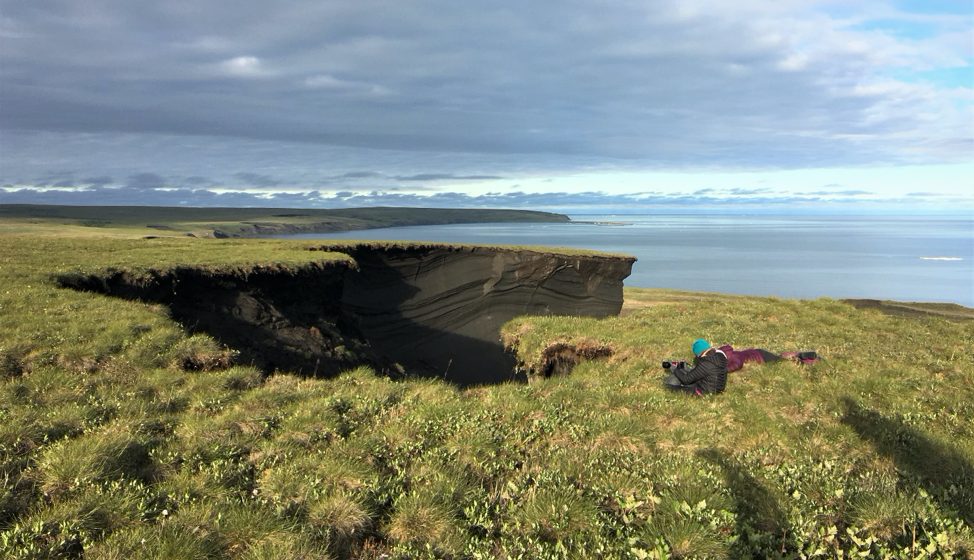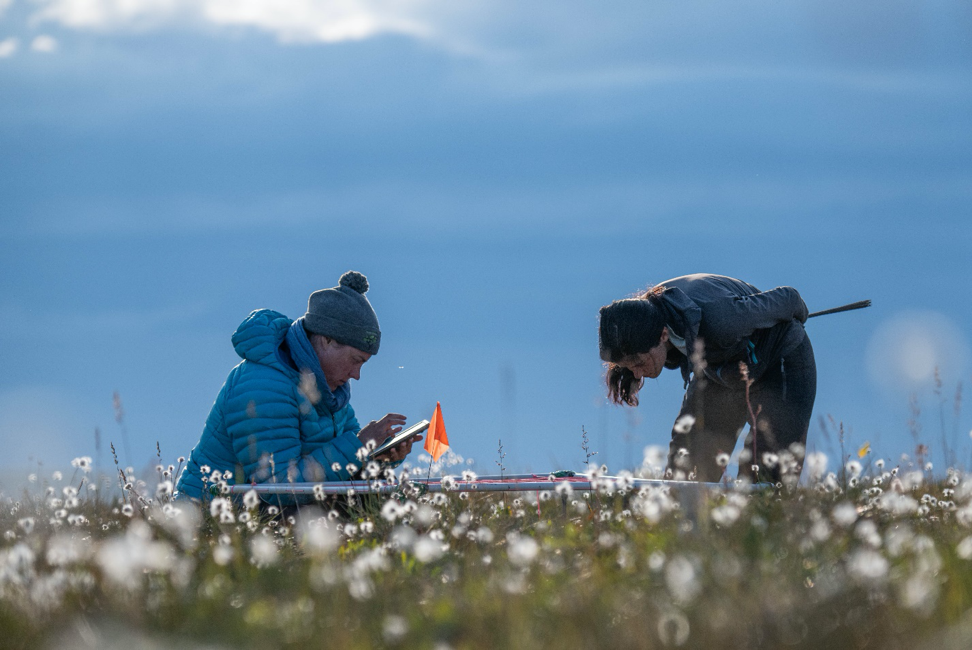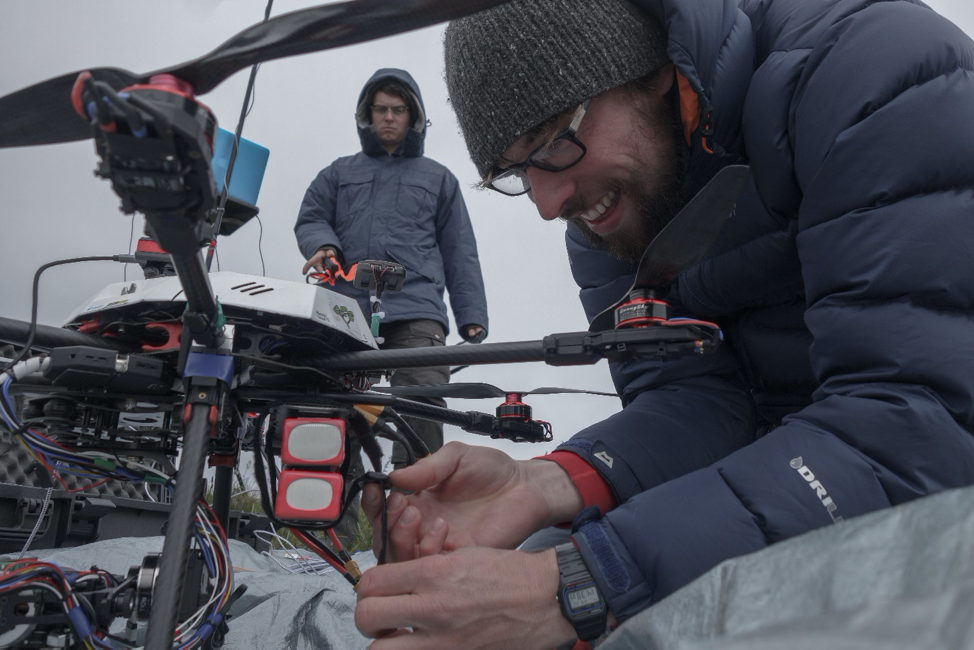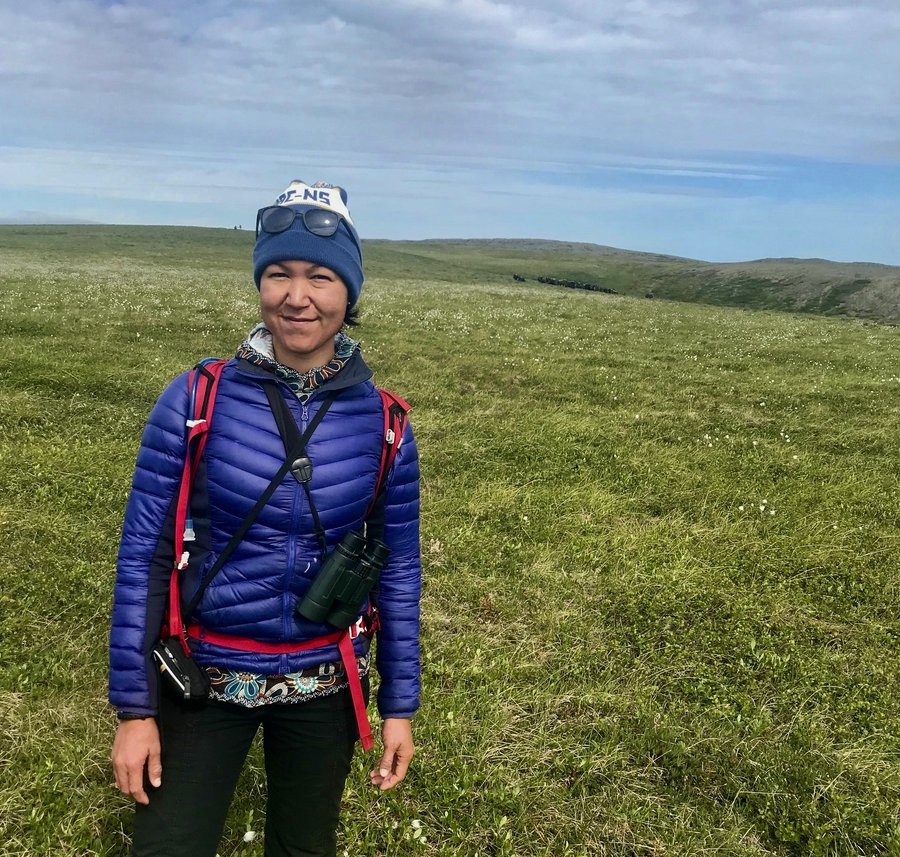Science Chats Part 6: Niptaqtuq
Posted on Nov. 3, 2020
The Yukon North Slope is an incredible place to do research, attracting scientists from around the world. And, while research findings are often published in academic journals for other scientists, what comes out of these projects is important for community members, wildlife managers, and local businesses. It is in everyone’s interest to communicate the science that is happening, and the values and interests of the Inuvialuit of the region.
We want to share some of this incredible work with you! Join us in these science chats and check out the video with Dr. Isla Myers-Smith from the University of Edinburgh, and Kayla Nanmak Arey an Inuvialuit from Aklavik, NWT as they talk about Team Shrub’s work on Qikiqtaruk (Herschel Island).
This sixth chat is titled Niptaqtuq, which means ‘a very clear and calm day.’

One of the large slumps on Qikiqtaruk, an example of an effect of thawing permafrost ©Kayla Nanmak Arey
The Island
Those of you who have been following along with our Science Chats will be familiar with Qikiqtaruk as a hot spot for ecological research and monitoring. In this latest edition, we're going to learn more about some of this cutting edge work, but first we need to lay the groundwork: why is Qikiqtaruk so special?
Qikiqtaruk became a territorial park in 1984. As a result of the Inuvialuit Final Agreement, it was the first park in the Yukon established under a comprehensive land claim agreement. Yet the story of Qikiqtaruk goes back much further than the mid-20th century! Qikiqtaruk – meaning ‘the Island’ in Inuvialuktun – is a traditional hunting and fishing place for Inuvialuit. It was, and still is, a place to stay. It is a central location between Tapqaq (Shingle Point), Pattuktuk (Demarcation Point), and the Firth River (Qikiqtaqruum Kuuna). Its rich and diverse environment has been providing for Inuvialuit for generations. Ecologically, it is home to marine mammals, flourishing migrating bird populations, terrestrial mammals as big as bears and as small as lemming, insects, and a plethora of plant and lichen communities.
As an arctic island, Qikiqtaruk is greatly affected by climate change. Its animals and plants are being forced to respond to rapid environmental changes, such as loss of sea ice, warming temperatures, thawing permafrost, and increased storm frequency and intensity. Often these changes exacerbate one another. For example, increased storm episodes lead to increased wave activity, which would have more impact on the shoreline and cause greater erosion; especially with thawing permafrost making the ground unstable.
Enter Team Shrub.
This team of researchers has been exploring the rates, causes, and relationships of ecological change on Qikiqtaruk.

Isla and Gergana Daskalova surveying tundra vegetation on Qikiqtaruk ©Jeffrey Kerby, National Geographic Society
Team Shrub
Vegetation communities in the arctic are influenced by many environmental factors. The growth and dispersal of plants rely on snow depth and period of snow cover, weather patterns, and relationships with animal species (i.e. insect pollinators, seed distribution from animal scat, etc.). Vegetation can also stabilize the ground, providing an anchor for the soil and a cold-insulting layer for the permafrost – just another way that all these processes work together! Everything is connected. Nothing functions with total independence.
This brings us back to Team Shrub, and Isla Myers-Smith’s work over the years. Why is increased shrub growth in the arctic important to study? It’s important because plants, animals, and the landscape itself, all respond to increased shrub growth in various ways. For plants, increased shrubs can mean that tundra specific plant species may get replaced over time by these shrubs, and in response the whole habitat can slowly change. A shift in food sources or growth patterns of vegetation can invoke a change in historically reliable places for animals to be found. If habitats change, animal movements change.
Team Shrub has been closely examining different scales of vegetation change on Qikiqtaruk. From hands on, nose-to-the-ground vegetation plots, to drone imagery for much larger landscape classifications, Team Shrub is employing a wide variety of methods to track these changes. After recording all this data, Team Shrub asks the questions: What story is the landscape telling right now? What can this vegetation change information tell us about the environment?
Well, it can tell us a lot!

Tech support for the drone! ©Jeffrey Kerby, National Geographic Society
Changes Happening Rapidly
Throughout the years that Isla has been working in and around the arctic, the research has shown an increase in shrub growth. As mentioned earlier, this can have many affects in an ecosystem because everything is connected. For example, increased shrub growth can affect the carbon stores in the ground. More shrubs on the tundra mean more trapped snow in the winter. Trapped snow insulates the ground and can prevent the soil from freezing, which further contributes to permafrost thaw and the potential release of carbon stores. On a large scale, the release of carbon stores can contribute to the warming environment, as permafrost contains more carbon than the atmosphere.
This can all become very overwhelming to think about. Team Shrub’s research happens locally, but the information collected contributes to this much bigger picture. The warming and increased shrub growth in the arctic will impact all life in the arctic. The research taking place, and the data that is being collected is telling us a story. We are in a state of flux, at a pace much quicker than we’ve ever had to adapt before.
We are a Part of This Story
I sometimes find myself overwhelmed when I think about the broader conversation of climate change. It can feel like there’s no way I can contribute to the issue in a meaningful way, I’m just one person. I ask myself how do I fit into this epic conversation? How does my family fit into this conversation? What about my community? These are not easy questions to consider. The magnitude of these issues can be daunting and stressful. But, often the toughest conversations to have are the most deserving of attention. And this conversation is happening whether I want it to or not. And if that’s the case, I choose to participate in it. I choose to acknowledge my role on this story. We all have the power to make this choice. And I believe it’s making this choice together that we can make our impact.
I also acknowledge the amazing people who are also active participants in the story. People at home, in the offices, and in the schools, all come together to learn about these issues and build on the knowledge that will help us address environmental changes. We are all connected, just like all the parts in an ecosystem. And we are all here to work together. At its core, Team Shrub exemplifies this: individuals working together to tell a story about one player within in a much grander narrative.

Our Science Chats series was created and developed by Kayla Nanmak Arey. She shares a little about herself below:
Nanmak is a name I share with my granny Jean Arey (my great grandmother). My nanak Nellie (grandmother), and my mom Carol say my granny was stubborn, and so was I. Inuvialuit names are passed down from generation to generation, and I am proud to have the name Nanmak. Translated, nanmak means to backpack. Specifically, for a working Inuit dog to carry things in, a nanmak.
